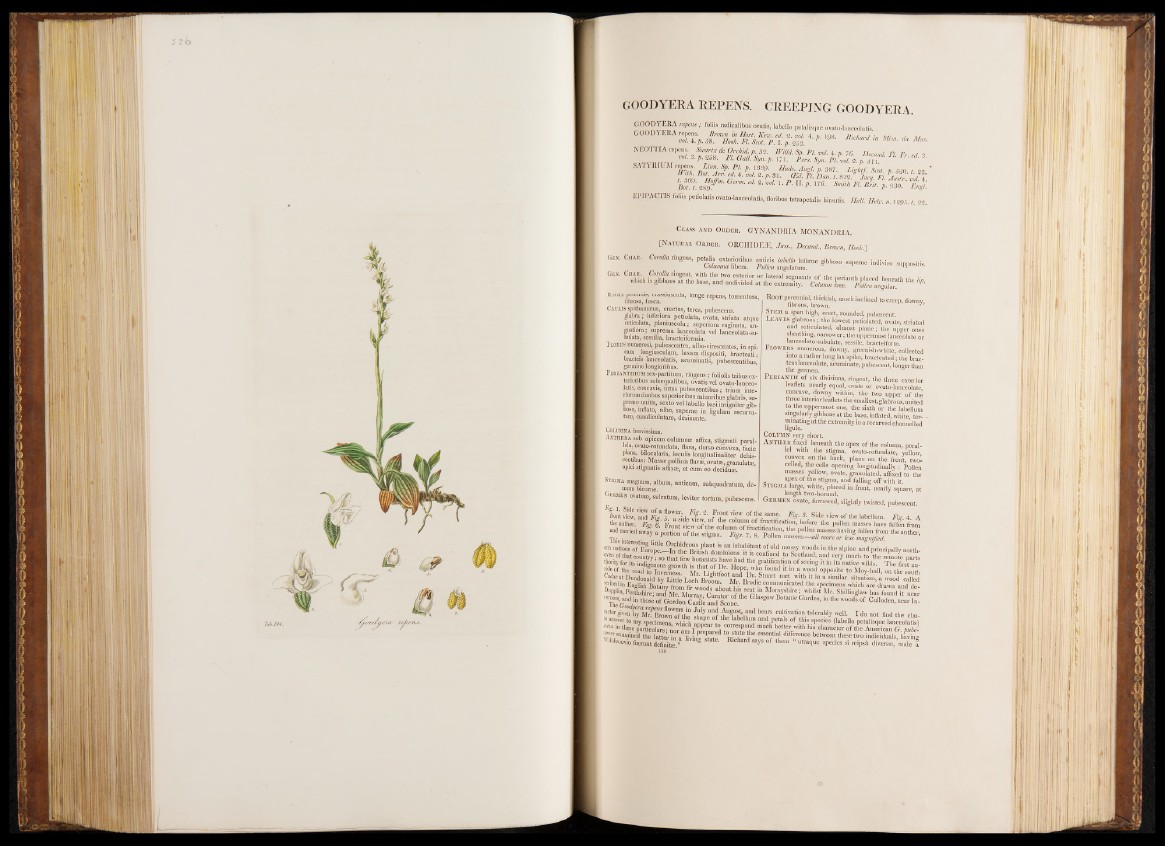
GOODYERA REPENS. CREEPING GOODYERA.
GOODYERA repas ; foliis radicalibus ovatis, labello petalisnue ovato-lanceolatis .
GOODYERA repens. Brown in Hart. Kew. ed. 2. ool. 4. ». 198. Richard in Mfon dn M,
m l.4 .p .S S . Hook. FI. Scot. P . I p 355 tuçhard m Mtm. in Mus
NEOTTIA repens. H | * O r « f S2. IFitld. Sp. P l e d . 4 .p. 76. B e en d . Fl. F , ed. 3
voi. 3. p . 25b. 1<L (fall. Syn. p. 171. Pers. Syn. PL ml. Q.p 5 \ \
SATYR [UM repens. Linn Sp. P i p. 1339: Buds. J w l . p. 387. Lightf. Scot. ». 520 r 22
1 3 6 9 Baffin WÉ m U H H 1 B i 81S- ■ W B u s,,-. H
Bot i. 289. G ' '• P - IL P' m ■ Smith Ä P 930. .B ^ /
EPIPACTIS foliis petiolatis ovato-landeolatis, fioribos tetmpetalis hirsntis. Hall. Helv. n. 1295. f„22
Class and Oedek. G YNANDRIA MONANDRIA.
[Naturae Order. ORCHIDEÆ, Pass., Decand., Brown, Hoch.]
e Gen-. Char. Corolla ringens, petalis exterioribus anticis labello infern gibboso supeme indiviso supposais.
Columnd libera. Pollen angulatuir
*■*
Ridix perennis, crassiuscula, longe repens, tomentosa,
fibrosa, fusca.
Cadlis spithamæus, erectus, teres, pubescens.
glabra ; inferiora petioiata, ovata, striata atque
reticulata, planiuscula ; superiora vaginata, an-
gustiora; suprema lanceolata vel lanceolato-su-
bulata, sessilia, bracteiformia.
Flores numerosi, pubescentes, albo-virescentes, in spi-
cam longiusculam, laxam dispositi, bracteati ;
bracteis lanceolatis, acuiijinatis, pubescentibus
genuine löngidribus.
Pekianthium sex-parti turn, ringens; foliolis tribus ex-
tenonbus submqualibus, ovatis vel ovato-lanceo-
latis, concavis, intus pubescentibus ; trium inte-
riorum duobus superioribus minoribus glabris, supremo
unitis, sexto vel labello basi insigniter gib-
boso, inflate, albo, superne in ligulam recurva-
tam, canaliculatam, desinente.
Root perennial, thickisb, i jeh inclined to creep, downy,
fibrous, brown.
' Stem a span high, erect, rounded, pubescent.
L eaves glabrous; the lowest petioiated, ovate, striated
and reticulated, almost plane; the upper ones
sheathing, narrower; the uppermost lanceolate or
ianceolato-subulate, Sessile, bracteiform.
Flowers numerous, downy, greenish-white, collected
into a rather long lax spike, bracteated; the brac-
teas lanceolate, acuminate, pubescent, longer than
the germen.
P e r ia n t h o f six divisions, ringent, the three exterior
leaflets nearly equal, ovate or ovato-lanceolate,
concave, downy within, the two upper o f the
three interior leaflets the smallest, glabrous, united
to the uppermost one, the sixth or the labellum
singularly gibbous at the base, inflated, white, ter- .
minuting a t the extremity in a recurved channelled
ligule.
Column very short.
An t h e r fixed beneath the apex o f the column, parallel
with the stigma, ovato-rotlindate, yellow,
convex on the back, plane on the front, two-
celled, the cells opening longitudinally : Pollen
masses yellow, ovate, granulated, affixed to the
apex of the stigma, and felling off with it.
TIGMA large, white, placed in front, nearly square, a t
length two-horned. 1
G ermen ovate, furrowed, slightly twisted, pubescent.
Columna brevissima.
Anthera sub apicem column® affixa, stigmati parallels,
ovato-rotundata, flava, dorso convexa, facie
plana, bilocularis, loculis longitudinaliter dehis-
centibus: Mass® pollinis flav®, ovat®, granulat®
apici stigmatis affix®, et cum eo decidu®. ’
Stichia magnum, album, anticum, subquadratum, de-
mum bicorne.
ermen ovatum, sulcatum, leviter tortum, pubescens.
r t a t v t t , a n d l l a f T s ride^fw2Wr S lTir .%• 3- Side view of the labellum. Fig. 4 A
the anther. 1 L „ 7 i 7 colu” " of “ “ t“ , before the pollen masses have fallen from
T“hdis riannf»fe d :v™. y. ap.ort.ion. of .the °stigm a! JT0g ° 7*’™ 't’ d■rolueeTn m asses.—all more 'o“r fles8s m“ a'g“nirfieTd. ■ a,,therera
nations of EuroM a^Britikh d' " “ inhabi.,ant op“ld raossy woods in the alpine and principally north-
rthorn °yf flo*ra itcoun™fs- J ”t t wt ^ t l i s l n r h a sd .heCOnHfle d ,-t0 of 7'ti nM its natiive wtoi ldths.e reTmhoef efi rps?S asu-
H “f the road £ Invade™ Mr a n d b f SnZ? i l “ ° PP° s,t,e <° Mor halli »“ 1 1 “ nth
k5m £ ' LrUe11 Mt. Brodle
T ? Ä in f11“ ' “f G o r d o n s ; and W . GksS°"'BotonIC m the woods of Cullodeu, near In- =tgi-eu by Mr B:o7 7 : f Am HSe a"t? V t hears cultivation tolerably well. Idu not “find Bthe cha
- to J, spécimens whth a i X r ^ n t “ “'V and.P f als of ,this sP“ tics (labello petalisqne lanceolatis)
«»• in these particulars ■ mr am T PP ‘ i o°rresP°”d mut;h better with his character of the American G pube-
W ex“'“ined the latte’r in a I f i E 6 7 S ® diflèrence between these two individuals, havinv
illdeiiovio fuerunt definite. ^ 8 El10,11‘rd s“>'s of them “ “traque species si reipsâ divers®, male a